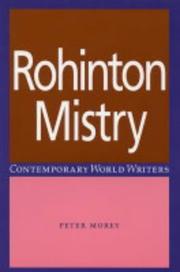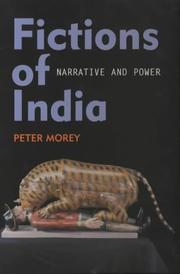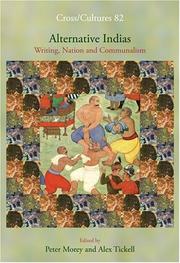| Listing 1 - 10 of 13 | << page >> |
Sort by
|

ISBN: 0719067154 0719067146 9780719067143 9780719067150 9786610734603 1781700583 1280734604 1847791034 9781526120656 9781847791030 9781280734601 9781781700587 1847795919 1526120658 9781847795915 Year: 2004 Publisher: Manchester ; New York : New York : Manchester University Press ; Distributed exclusively in the USA by Palgrave,
Abstract | Keywords | Export | Availability | Bookmark
 Loading...
Loading...Choose an application
- Reference Manager
- EndNote
- RefWorks (Direct export to RefWorks)
This study - the first of its kind - situates Rohinton Mistry's writing in its cultural and historical context. It explores key features, such as the legacy of Zoroastrianism, Parsi anglophilia, recent Indian history, the conventions of oral storytellling common to Persia and South Asia, and the experience of migration which now sees him living in Canada. The texts are viewed through the lens of diaspora and minority discourse theories to show how Mistry's writing is illustrative of marginal positions in relation to sanctioned national identities.
English Literature --- English --- Languages & Literatures --- 820 "19" MISTRY, ROHINTON --- Engelse literatuur--20e eeuw. Periode 1900-1999--MISTRY, ROHINTON --- Mistry, Rohinton, --- Criticism and interpretation. --- Rohinton Mistry, --- מיסטרי, רוהינטון, --- Literary studies: fiction, novelists & prose writers --- literature --- mistry --- postcolonial --- parsi --- India --- Jahangir --- Mumbai --- Parsis --- Zoroastrianism --- Literature --- Literary Studies: Fiction, Novelists & Prose Writers --- LITERARY CRITICISM / Asian / General --- Asia --- LITERARY CRITICISM / Asian / General. --- Family Matters. --- Fine Balance. --- India. --- Indian political history. --- Man Booker Prize. --- Parsee. --- Rohinton Mistry. --- diaspora. --- migration. --- postcolonial literature.

ISBN: 0748611819 Year: 2000 Publisher: Edinburgh : Edinburgh university press,
Abstract | Keywords | Export | Availability | Bookmark
 Loading...
Loading...Choose an application
- Reference Manager
- EndNote
- RefWorks (Direct export to RefWorks)
Anglo-Indian fiction --- English fiction --- Indic fiction (English) --- Narration (Rhetoric). --- Power (Social sciences) in literature. --- History and criticism. --- History and criticism --- KIPLING (RUDYARD), 1865-1936 --- FARRELL (J.G.) --- SCOTT (PAUL) --- SINGH (KUSHWANT) --- FORSTER (EDWARD MORGAN), 1879-1970 --- MISTRY (ROHINTON), 1952 --- -INDE DANS LA LITTERATURE --- RAJ QUARTET
Book
ISBN: 9780231541336 0231541333 9780231177740 0231177747 Year: 2018 Publisher: New York
Abstract | Keywords | Export | Availability | Bookmark
 Loading...
Loading...Choose an application
- Reference Manager
- EndNote
- RefWorks (Direct export to RefWorks)
In an era of rampant Islamophobia, what do literary representations of Muslims and anti-Muslim bigotry tell us about changing concepts of cultural difference? In Islamophobia and the Novel, Peter Morey analyzes how recent works of fiction have framed and responded to the rise of anti-Muslim prejudice, showing how their portrayals of Muslims both reflect and refute the ideological preoccupations of media and politicians in the post-9/11 West.Islamophobia and the Novel discusses novels embodying a range of positions-from the avowedly secular to the religious, and from texts that appear to underwrite Western assumptions of cultural superiority to those that recognize and critique neoimperial impulses. Morey offers nuanced readings of works by John Updike, Ian McEwan, Hanif Kureishi, Monica Ali, Mohsin Hamid, John le Carré, Khaled Hosseini, Azar Nafisi, and other writers, emphasizing the demands of the literary marketplace for representations of Muslims. He explores how depictions of Muslim experience have challenged liberal assumptions regarding the novel's potential for empathy and its ability to encompass a variety of voices. Morey argues for a greater degree of critical self-consciousness in our understanding of writing by and about Muslims, in contrast to both exclusionary nationalism and the fetishization of difference. Contemporary literature's capacity to unveil the conflicted nature of anti-Muslim bigotry expands our range of resources to combat Islamophobia. This, in turn, might contribute to Islamophobia's eventual dismantling.
Islamophobia in literature --- Fiction --- Muslims in literature --- Metafiction --- Novellas (Short novels) --- Novels --- Stories --- Literature --- Novelists --- History and criticism --- Philosophy --- E-books --- Islamophobia in literature. --- Muslims in literature. --- History and criticism.

ISBN: 058545082X 9780585450827 0748611819 9780748611812 Year: 2000 Publisher: Edinburgh Edinburgh University Press
Abstract | Keywords | Export | Availability | Bookmark
 Loading...
Loading...Choose an application
- Reference Manager
- EndNote
- RefWorks (Direct export to RefWorks)
GBS_insertPreviewButtonPopup('ISBN:9780748611812);Fictions of India explores the relation of narrative technique to issues of power in the work of selected writers dealing with India. It examines the imperial context in which the writers operate and suggests how historical and ideological assumptions and anxieties may be read into the texts they produce. The study combines aspects of colonial and post-colonial debate with narrative theories to illuminate the work of these writers operating on either side of an epistemological divide formed by Indian independence in 1947.The book focuses largely on British writers on India with chapters on Kipling, E.M. Forster, John Masters, J.G. Farrell and Paul Scott. A final, comparative chapter traces the issues of narrative and power in the work of two post-independence Indian writers - Khushwant Singh and Rohinton Mistry - and deals with the burden of storytelling in a post-colonial situation still fraught with communal and neo-colonial abuses.This book is an important contribution to our understanding of how narrative fiction can reflect and confirm, but also contest and dismantle discourses of power.Key FeaturesOffers new interpretations of well-known texts and writersSuggests an agenda for studying new and less well-known texts to examine the play of narrative and power more generallyDemonstrates possible relations between narrative technique and those larger narratives which feed into the operation of political powerChallenges exclusivist readings which have often asserted 'the colonial' and 'the post-colonial' to be antithetical and mutually exclusive discursive entities"
English fiction --- Anglo-Indian fiction --- Indic fiction (English) --- Power (Social sciences) in literature --- Narration (Rhetoric) --- English --- English Literature --- Languages & Literatures --- Narrative (Rhetoric) --- Narrative writing --- Rhetoric --- Discourse analysis, Narrative --- Narratees (Rhetoric) --- History and criticism --- India --- In literature. --- History and criticism.
Digital
ISBN: 9780231541336 9780231177740 Year: 2018 Publisher: New York, N.Y. Columbia University Press
Abstract | Keywords | Export | Availability | Bookmark
 Loading...
Loading...Choose an application
- Reference Manager
- EndNote
- RefWorks (Direct export to RefWorks)
Digital
ISBN: 9780585450827 9780748611812 Year: 2022 Publisher: Edinburgh Edinburgh University Press
Abstract | Keywords | Export | Availability | Bookmark
 Loading...
Loading...Choose an application
- Reference Manager
- EndNote
- RefWorks (Direct export to RefWorks)

ISBN: 9042019271 9401202591 1423789040 9781423789048 9789401202596 9789042019270 Year: 2005 Publisher: Amsterdam New York Rodopi
Abstract | Keywords | Export | Availability | Bookmark
 Loading...
Loading...Choose an application
- Reference Manager
- EndNote
- RefWorks (Direct export to RefWorks)
The debate over whether religious or secular identities provide the most viable model for a wider national identity has been a continuous feature of Indian politics from the late nineteenth century to the present day. Moreover, in the last thirty years the increasingly communal articulation of popular politics and the gradual rise of a constellation of Hindu nationalist parties headed by the BJP has increased the urgency of this debate. While Indian writing in English has fostered a long tradition of political dissent, and has repeatedly questioned ethnocentric, culturally exclusive forms of political identification, few critics have considered how this literature engages directly with communalism, or charted the literary-political response to key events such as the Babri Masjid / Ramjanmabhumi affair and the recent growth of popular forms of Hindu nationalism. The essays collected in Alternative Indias break new ground in studies of Indian literature and film by discussing how key authors offer contending, 'alternative' visions of India and how poetry, fiction and film can revise both the communal and secular versions of national belonging that define current debates about 'Indianness'. Including contributions from international scholars distinguished in the field of South Asian literary studies, and featuring an informative introduction charting the parallel developments of writing, the nation and communal consciousness, Alternative Indias offers a fresh perspective on the connections and discontinuities between culture and politics in the world's biggest democracy.
Book
ISBN: 0674061144 9780674061149 9780674048522 0674048520 Year: 2011 Publisher: Cambridge, Mass. Harvard University Press
Abstract | Keywords | Export | Availability | Bookmark
 Loading...
Loading...Choose an application
- Reference Manager
- EndNote
- RefWorks (Direct export to RefWorks)
Can Muslims ever fully be citizens of the West? Can the values of Islam ever be brought into accord with the individual freedoms central to the civic identity of Western nations? Not if you believe what you see on TV. Whether the bearded fanatic, the veiled, oppressed female, or the shadowy terrorist plotting our destruction, crude stereotypes permeate public representations of Muslims in the United States and western Europe. But these ";Muslims"; are caricatures-distorted abstractions, wrought in the most garish colors, that serve to reduce the diversity and complexity of the Muslim world to a set of fixed objects suitable for sound bites and not much else.In Framing Muslims: Stereotyping and Representation after 9/11, Peter Morey and Amina Yaqin dissect the ways in which stereotypes depicting Muslims as an inherently problematic presence in the West are constructed, deployed, and circulated in the public imagination, producing an immense gulf between representation and a considerably more complex reality. Crucially, they show that these stereotypes are not solely the province of crude-minded demagogues and their tabloid megaphones, but multiply as well from the lips of supposedly progressive elites, even those who presume to speak ";from within,"; on Muslims' behalf. Based on nuanced analyses of cultural representations in both the United States and the UK, the authors draw our attention to a circulation of stereotypes about Muslims that sometimes globalizes local biases and, at other times, brings national differences into sharper relief.
Stereotypes (Social psychology) --- Muslims in popular culture --- Popular culture
Digital
ISBN: 9780674061149 9780674048522 Year: 2011 Publisher: Cambridge, Mass. Harvard University Press
Abstract | Keywords | Export | Availability | Bookmark
 Loading...
Loading...Choose an application
- Reference Manager
- EndNote
- RefWorks (Direct export to RefWorks)
Book
ISBN: 9780415896771 9781138851580 9780203129623 9781136473357 9781136473395 9781136473401 1138851582 0203129628 0415896770 Year: 2014 Volume: 38 Publisher: New York (N.Y.): Routledge,
Abstract | Keywords | Export | Availability | Bookmark
 Loading...
Loading...Choose an application
- Reference Manager
- EndNote
- RefWorks (Direct export to RefWorks)
English fiction --- American fiction --- Islam in literature. --- Muslims in literature. --- Muslim authors --- Identity (Psychology) in literature. --- Islam and culture. --- Muslim diaspora. --- Islam and literature. --- History and criticism. --- Political and social views. --- Islam in literature --- Muslims in literature --- Identity (Psychology) in literature --- Islam and culture --- Muslim diaspora --- Islam and literature --- History and criticism --- Political and social views --- English fiction - Muslim authors - History and criticism --- American fiction - Muslim authors - History and criticism --- Muslim authors - Political and social views
| Listing 1 - 10 of 13 | << page >> |
Sort by
|

 Search
Search Feedback
Feedback About UniCat
About UniCat  Help
Help News
News